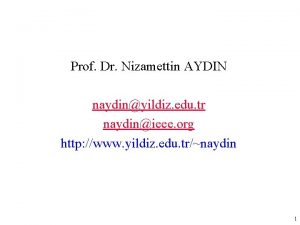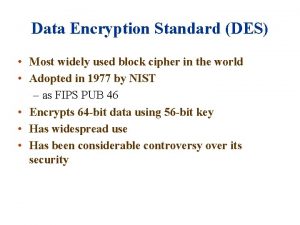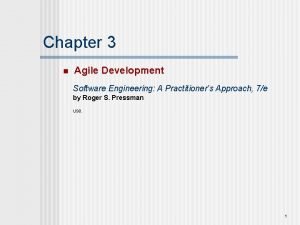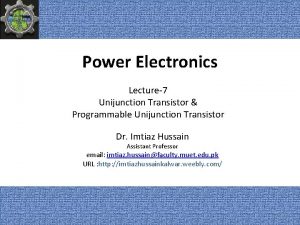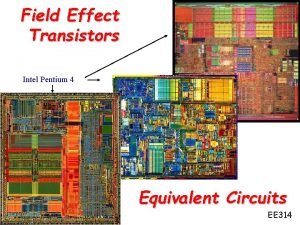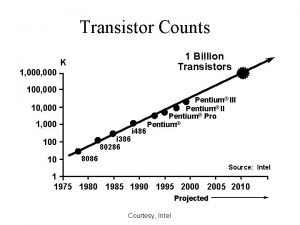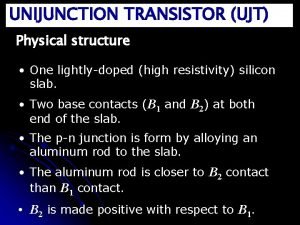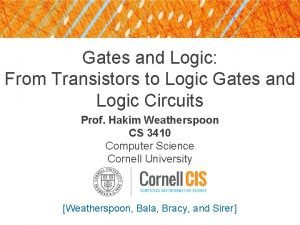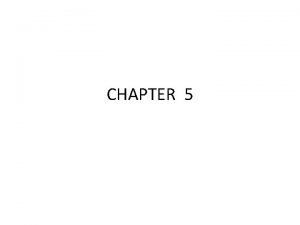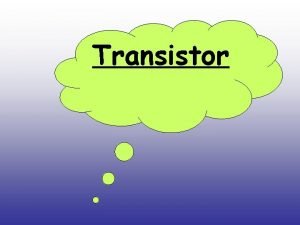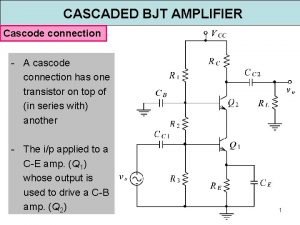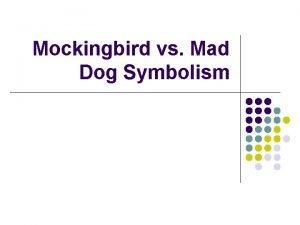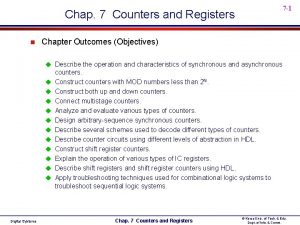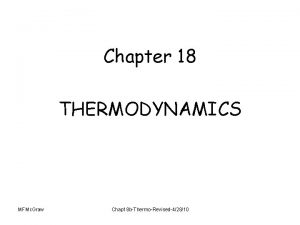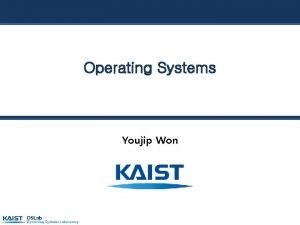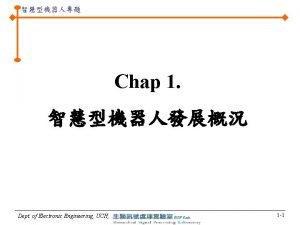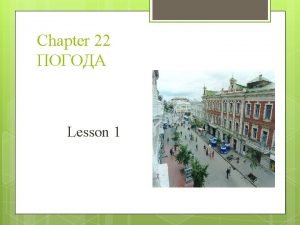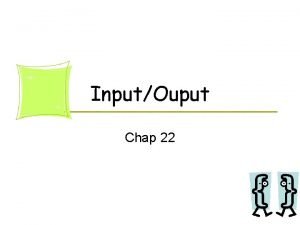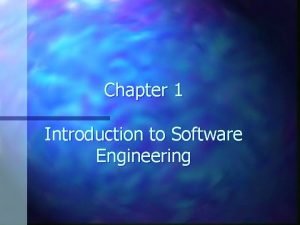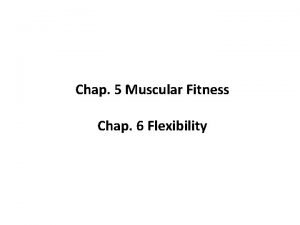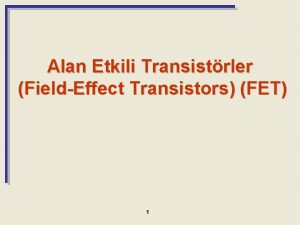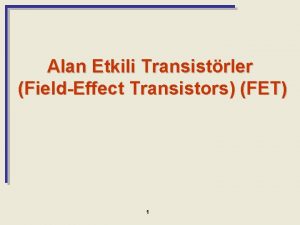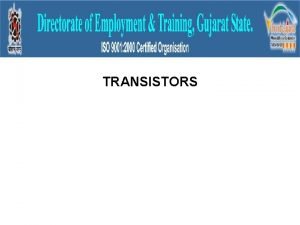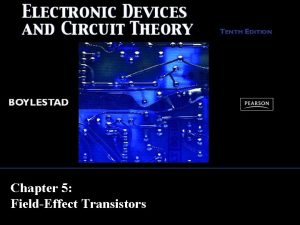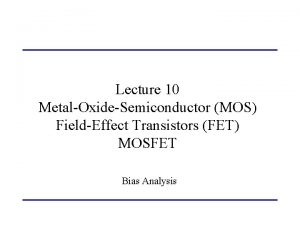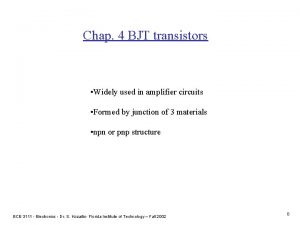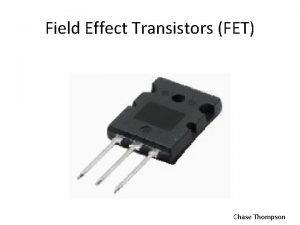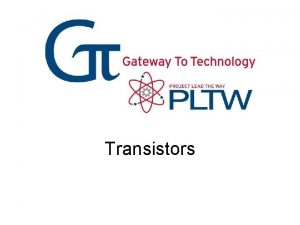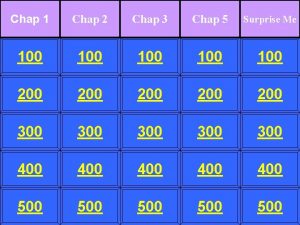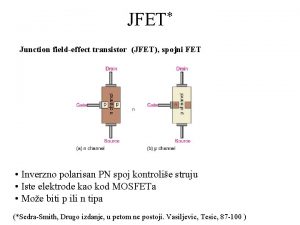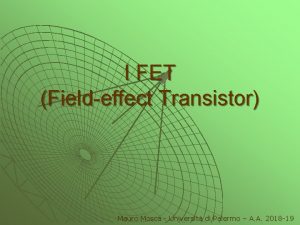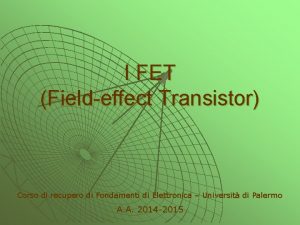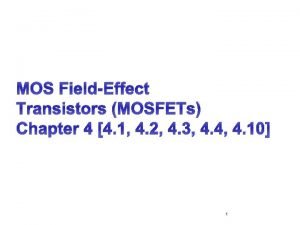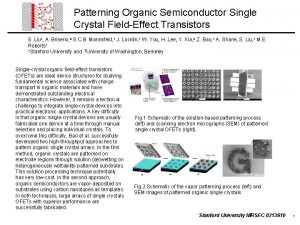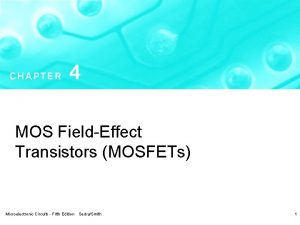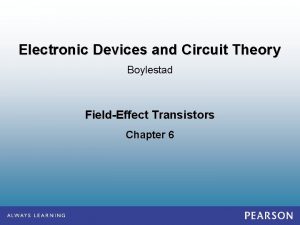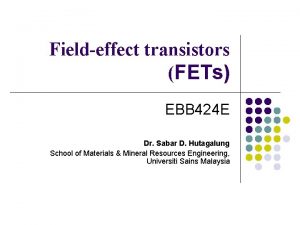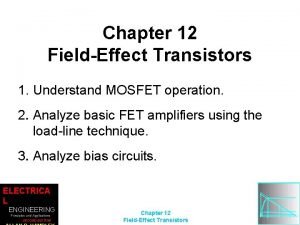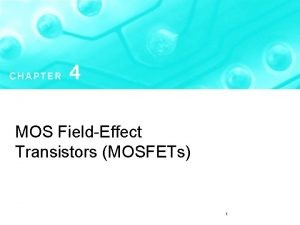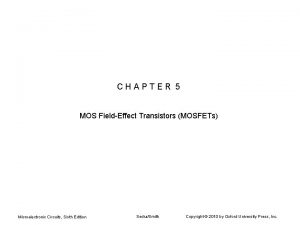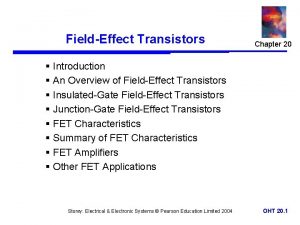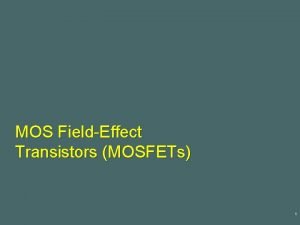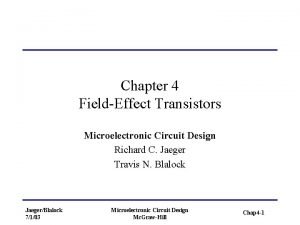Chap 5 Fieldeffect transistors FET Widely used in



















![Transconductance = gm = d. ID/d. VGS = d [K(VGS-VT)2]/d. VGS = 2 K(VGS-VT) Transconductance = gm = d. ID/d. VGS = d [K(VGS-VT)2]/d. VGS = 2 K(VGS-VT)](https://slidetodoc.com/presentation_image/521ce1e89ec2ebd61e14b17c4bcc5ddc/image-20.jpg)















- Slides: 35

Chap. 5 Field-effect transistors (FET) • Widely used in VLSI • used in some analog amplifiers - output stage of power amplifers (may have good thermal characteristics if designed properly) • n-channel or p-channel structure • FET - voltage controlled device • BJT - current controlled device ECE 3111 - Electronics - Dr. S. Kozaitis- Florida Institute of Technology - Fall 2002 0

Physical structure of a n-channel device: Typically L = 0. 35 to 10 m, W = 2 to 500 m, and the thickness of the oxide layer is in the range of 0. 02 to 0. 1 m. ECE 3111 - Electronics - Dr. S. Kozaitis- Florida Institute of Technology - Fall 2002 1

MOSFETs • MOS - metal oxide semicondutor structure (original devices had metal gates, now they are silicon) • NMOS - n-channel MOSFET • PMOS - p-channel MOSFET • CMOS - complementary MOS, both n-channel and p-channel devices used in conjuction with each other (most popular in IC’s) • MESFET - metal semiconductor structure, used in high-speed Ga. As devices • JFET - junction FET, early type of FET ECE 3111 - Electronics - Dr. S. Kozaitis- Florida Institute of Technology - Fall 2002 2

CMOS Cross section of a CMOS integrated circuit. Note that the PMOS transistor is formed in a separate n-type region, known as an n well. ECE 3111 - Electronics - Dr. S. Kozaitis- Florida Institute of Technology - Fall 2002 3

If VGS > VT (threshold voltage), an induced, conducting n-channel forms between the drain and source. The channel conductance is proportional to v. GS - Vt. ECE 3111 - Electronics - Dr. S. Kozaitis- Florida Institute of Technology - Fall 2002 4

Symbols and conventions drain • n-channel gate + VDS - + VGS - • several slightly different symbols source (source is often connected to the substrate which is usually grounded) ECE 3111 - Electronics - Dr. S. Kozaitis- Florida Institute of Technology - Fall 2002 5

Symbols and conventions drain • p-channel gate + VDS - + VGS - • several slightly different symbols source (source is often connected to VDD) ECE 3111 - Electronics - Dr. S. Kozaitis- Florida Institute of Technology - Fall 2002 6

Output characteristics (n-channel) (linear) + VDS - An n-channel MOSFET with VGS and VDS applied and with the normal directions of current flow indicated. ECE 3111 - Electronics - Dr. S. Kozaitis- Florida Institute of Technology - Fall 2002 7

Input characteristics (n-channel) + VDS - ECE 3111 - Electronics - Dr. S. Kozaitis- Florida Institute of Technology - Fall 2002 ID = K(VGS-VT)2 8

Summary of MOSFET behavior (n-channel) • VGS > VT (threshold voltage) for the device to be on • VDS > VGS - VT for device to be in saturation region • ID = K(VGS-VT)2 • Enhancement mode device, VT > 0 • Depletion mode device, VT < 0 (conducts with VGS = 0) ECE 3111 - Electronics - Dr. S. Kozaitis- Florida Institute of Technology - Fall 2002 9

Comparison of BJT and FET BJT • current controlled FET • voltage controlled • VBE 0. 7 V for device to be on • VGS > VT for device to be on • operates in linear region (amplifier); • operates in saturation region (amplifier); VDS > VGS - VT BE junction forward biased, BC junction reversed biased • IC = b. IB • ID = K(VGS-VT)2 ECE 3111 - Electronics - Dr. S. Kozaitis- Florida Institute of Technology - Fall 2002 10

MOSFET aspect ratio ID = K(VGS-VT)2 K = transconductance parameter K = 1/2 K' (W/L) K' = n. Cox, where n is the mobility of electrons, and Cox is the capacitance of the oxide W/L is the aspect ratio, W is the width of the gate, L is the length of the gate. ID W/L ECE 3111 - Electronics - Dr. S. Kozaitis- Florida Institute of Technology - Fall 2002 11

Prob 5. 41(a) Given: VT = 2 V, K = (1/2). 5 m. A/V 2 ID IG = 0 (a) Find V 1 Use, + VGS - V 1 ID = K(VGS-VT)2 10 u. A = (1/2). 5 (VGS - 2)2 Solve for VGS n channel VGS = 2. 2 V V 1 = - 2. 2 V ECE 3111 - Electronics - Dr. S. Kozaitis- Florida Institute of Technology - Fall 2002 12

Prob 5. 41(b) Given: VT = 2 V, K = (1/2). 5 m. A/V 2 (b) Find V 2 IG = 0 Use, ID = K(VGS-VT)2 10 u. A = (1/2). 5 (VGS - 2)2 + VGS - n channel ID Solve for VGS = 2. 2 V V 2 = VGS = 2. 2 V ECE 3111 - Electronics - Dr. S. Kozaitis- Florida Institute of Technology - Fall 2002 13

Prob 5. 41(f) Given: VT = 2 V, K = (1/2). 5 m. A/V 2 (f) Find VGS Equate current in load and transistor IG = 0 ID + VGS - n channel Current in transistor: ID = K(VGS-VT)2 Current in resistor: I = (5 - VGS) /100 K Equate currents (5 - VGS) /100 K = (1/2). 5 (VGS - 2)2 Solve for VGS = 2. 33 V ECE 3111 - Electronics - Dr. S. Kozaitis- Florida Institute of Technology - Fall 2002 14

5. 4 MOSFETS at DC DC problem Find ID, and VGS, and VDS VGS = 5 V VGS > VT, so device is on Assume device is in saturation ID = K(VGS-VT)2 ID = (0. 05 m. A/V 2)(5 -1)2 ID = 0. 8 m. A VDS = VDD - ID RD VDS = 10 - (0. 8)6 VDS = 5. 2 V ECE 3111 - Electronics - Dr. S. Kozaitis- Florida Institute of Technology - Fall 2002 ID IG = 0 + VDS - + VGS - ID VT = 1 V K = 0. 05 m. A/V 2 (typical values) 15

General DC problem Find ID, and VGS Assume device is in saturation ID = K(VGS-VT)2 ID = K(5 - ID RS -VT)2 18 ID 2 - 25 ID + 8 = 0 Solve for ID, use quadratic formula ID = 0. 89 m. A, 0. 5 m. A, which is correct? For ID = 0. 89 m. A, VGS = 5 - (0. 89)6 = - 0. 34 V For ID = 0. 5 m. A, VGS = 5 - (05)6 = 2 V Only for ID = 0. 5 m. A, is transistor on! ECE 3111 - Electronics - Dr. S. Kozaitis- Florida Institute of Technology - Fall 2002 IG = 0 + VDS - + VGS - ID VT = 1 V, K = 0. 5 m. A/V 2 16

DC problem: two FETs in series Find V IG = 0 If devices are identical VDD = 5 V IG = 0 V device V =VDD/2 = 2. 5 V ID device Ground n channel ECE 3111 - Electronics - Dr. S. Kozaitis- Florida Institute of Technology - Fall 2002 17

5. 5 MOSFET as an amplifier g . d d + Ro vgs g - s ac model s n channel g d + vgs Ro = 1/slope of the output characteristics - s SPICE model ECE 3111 - Electronics - Dr. S. Kozaitis- Florida Institute of Technology - Fall 2002 18
![Transconductance gm d IDd VGS d KVGSVT2d VGS 2 KVGSVT Transconductance = gm = d. ID/d. VGS = d [K(VGS-VT)2]/d. VGS = 2 K(VGS-VT)](https://slidetodoc.com/presentation_image/521ce1e89ec2ebd61e14b17c4bcc5ddc/image-20.jpg)
Transconductance = gm = d. ID/d. VGS = d [K(VGS-VT)2]/d. VGS = 2 K(VGS-VT) Useful relation: gm = 2 K ID ECE 3111 - Electronics - Dr. S. Kozaitis- Florida Institute of Technology - Fall 2002 19

Prob. 5. 86 (a) Find the resistance of an enhancement load + I g d V - Rin s ac model Rin = resistance of current source || Ro resistance of current source = voltage across current source / current in current source resistance of current source = vgs / gmvgs = 1/gm Replace current source by a resistor of resistance 1/gm ECE 3111 - Electronics - Dr. S. Kozaitis- Florida Institute of Technology - Fall 2002 20

Prob. 5. 86 (a) Find the resistance of an enhancement load Often, Ro >> 1/gm ECE 3111 - Electronics - Dr. S. Kozaitis- Florida Institute of Technology - Fall 2002 21

Prob. 5. 86 (b) To raise the resistance of the transistor by a factor of 3, what must be done? R 1/gm = 1 / 2 K ID = [1/2 ] [1/ K] [ 1/ ID] = [1/2 ] [1/ 1/2 K W/L ] [ 1/ ID] • Decrease ID by a factor of 9 • Decrease W by a factor of 9 • Increase L by a factor of 9 ECE 3111 - Electronics - Dr. S. Kozaitis- Florida Institute of Technology - Fall 2002 22

5. 7 Integrated Circuit MOSFET amplifiers • Resistors take up too much space on an integrated ciruit (IC) • Use transistors as loads Typical amplifier DC analysis ID Equate current in Q 1 and load I in Q 1 = I in load K(VGS-VT)2 = I in load ID ECE 3111 - Electronics - Dr. S. Kozaitis- Florida Institute of Technology - Fall 2002 23

ac analysis of MOSFET amplifiers g ID d + vgs - s Rin Rout ac circuit ID Rin = Rout = Rload || Ro ECE 3111 - Electronics - Dr. S. Kozaitis- Florida Institute of Technology - Fall 2002 24

ac analysis of MOSFET amplifiers g iin = 0 d -gmvgs + vgs - - s Ai = iout / iin = + vout Av = vout/vin = -gmvgs(Ro || Rload) / vgs = -gm(Ro || Rload) ECE 3111 - Electronics - Dr. S. Kozaitis- Florida Institute of Technology - Fall 2002 25

Transistor loads: depletion load VGS = 0 Depletion load I + V - R = Ro || resistance of current source with 0 magnitude = Ro || Ro = |VA| / I Resistance is current dependent = Ro ECE 3111 - Electronics - Dr. S. Kozaitis- Florida Institute of Technology - Fall 2002 26

CMOS amp • Q 2 and Q 3 form a p-channel current mirror load for Q 1 • Q 4 and Q 3 establish Iref I = Iref due to current mirror Iref I ECE 3111 - Electronics - Dr. S. Kozaitis- Florida Institute of Technology - Fall 2002 Given: |VT| = 1 V, |VA| = 50 V p-channel p. Cox = 20 A/V 2 n-channel n. Cox = 40 A/V 2 WQ 1 = Wp = 100 m WQ 4 = 50 m L = 10 m 27

CMOS amp: power Iref I Given: |VT| = 1 V, |VA| = 50 V p-channel p. Cox = 20 A/V 2 n-channel n. Cox = 40 A/V 2 WQ 1 = Wp = 100 m WQ 4 = 50 m L = 10 m Find Total power consumed • Power consumed = 2 Iref. VDD • Equate currents in Q 3 and Q 4 to find Iref • IQ 3 = IQ 4 = K 3(VGS-VT)2 = K 4(VGS-VT)2 • Note that K’s are the same: K 3 = (1/2)(20)(100/10) = K 4 = (1/2)(40)(50/10) • Therefore, Q 3 and Q 4 behave the same, so VGS 3 = VGS 4 = 2. 5 V • Iref = K 4(VGS-VT)2 = (1/2)(40)(50/10) (2. 5 - 1)2 = 225 A • Power consumed = (2) 5 V 225 A = 2. 25 m. W 28 ECE 3111 - Electronics - Dr. S. Kozaitis- Florida Institute of Technology - Fall 2002

CMOS amp: DC analysis Iref Given: |VT| = 1 V, |VA| = 50 V p-channel p. Cox = 20 A/V 2 n-channel n. Cox = 40 A/V 2 WQ 1 = Wp = 100 m WQ 4 = 50 m L = 10 m + Vout - Find Vout • Consider current in Q 1 or Q 2 • Using Q 1, IQ 1 = K 1(VGS-VT)2 where VGS = Vout 225 A = (1/2)(40)(100/10) (VGS - 1)2 • Solve for VGS, VGS = Vout = 1. 75 V ECE 3111 - Electronics - Dr. S. Kozaitis- Florida Institute of Technology - Fall 2002 29

CMOS amp: ac analysis Given: |VT| = 1 V, |VA| = 50 V p-channel p. Cox = 20 A/V 2 n-channel n. Cox = 40 A/V 2 WQ 1 = Wp = 100 m WQ 4 = 50 m L = 10 m Iref + Vout Find Av Av = -gm 1(Ro 1 || Ro 2) - Ro 1= Ro 2 = 50/ 225 A = 222 KW gm = 2 K ID = (2) [(1/2)(40)(100/10)] 1/2 225 A = 300 A/V Av = -gm 1(Ro 1 || Ro 2) = -300(. 222/2) -33 ECE 3111 - Electronics - Dr. S. Kozaitis- Florida Institute of Technology - Fall 2002 30

CMOS multistage amp: ac analysis DC circuit ac circuit (neglects resistances of current sources) ECE 3111 - Electronics - Dr. S. Kozaitis- Florida Institute of Technology - Fall 2002 31

CMOS multistage amp: ac analysis Av of stage 1: Vout 1/Vgs 1 = -gm 1 Vgs 1 Ro 1/Vgs 1 = -gm 1 ro 1 Av of stage 2: Vout 2/Vgs 2 = -gm 2 Vgs 2 Ro 2/Vgs 2 = -gm 2 ro 2 Overall Av = (-gm 1 ro 1) ( -gm 2 ro 2) = gm 1 gm 2 ro 1 ro 2 ECE 3111 - Electronics - Dr. S. Kozaitis- Florida Institute of Technology - Fall 2002 32

Multistage CMOS amp: DC analysis Iref • Q 3 and Q 6 form a PMOS current mirror load for Q 4 • Q 1 and Q 5 form an NMOS current mirror load for Q 2 • Q 5 and Q 6 establish the current in Q 1, Q 2, Q 3 and Q 4 • The width of Q 5 is adjusted to give a particular Iref ECE 3111 - Electronics - Dr. S. Kozaitis- Florida Institute of Technology - Fall 2002 33

Multistage CMOS amp: DC analysis • Equate currents in Q 5 and Q 6 • IQ 5 = IQ 6 = K 5(VGS 5 -VT)2 = K 6((VGS 5 VDD)-VT)2 • Solve for VGS 5, Use VGS 5 to find Iref • Other current s are multiples of Iref • K 3/K 6 = IQ 3/Iref • K 1/K 5 = IQ 1/Iref • Find VD 4, and VD 1 = Vout from currents in those transistors • Given KP = 80 A/V 2, KN = 100 A/V 2, |VT| = 1 V, VDD = 9 V 100(VGS 5 - 1)2 = 80((VGS 5 - 9) - (- 1))2, VGS 5 = 5. 14 V, 48. 9 V Find Iref, 100(5. 14 - 1)2 = 1. 7 m. A IQ 3 = IQ 4 = IQ 2 = IQ 1 because all KN’s and KP’s are equal ECE 3111 - Electronics - Dr. S. Kozaitis- Florida Institute of Technology - Fall 2002 34
 Chap chap slide
Chap chap slide Giga tera
Giga tera Basic components of computer
Basic components of computer The biomedical treatment most widely used today is
The biomedical treatment most widely used today is Widely used method
Widely used method Types of sheet metal joints
Types of sheet metal joints Des initial permutation calculator
Des initial permutation calculator The most widely used agile process, originally proposed by
The most widely used agile process, originally proposed by Big data analytics with r and hadoop
Big data analytics with r and hadoop Ujt in electronics
Ujt in electronics Graphical analysis
Graphical analysis 8086 transistor count
8086 transistor count Application des transistors bipolaires
Application des transistors bipolaires Ujt relaxation oscillator
Ujt relaxation oscillator Which gate
Which gate Interpretations of moore's law assert that:
Interpretations of moore's law assert that: P type bjt
P type bjt Cascode amplifier analysis
Cascode amplifier analysis Culture and the workplace
Culture and the workplace Rapid diffusion of popular culture
Rapid diffusion of popular culture ______ was widely-practiced in african society.
______ was widely-practiced in african society. Most widely practiced religion
Most widely practiced religion Mad dog ch 25
Mad dog ch 25 Chap counter
Chap counter The origin of species manga chapter 24
The origin of species manga chapter 24 To not die chap 18
To not die chap 18 1 of 1 clothing meaning
1 of 1 clothing meaning Youjip won
Youjip won Define the relationship chapter 12
Define the relationship chapter 12 Chap 1
Chap 1 In the summer chap 22
In the summer chap 22 Chap 22
Chap 22 Physical fitness elements
Physical fitness elements System engineer chap 1
System engineer chap 1 Fitness chap 70
Fitness chap 70 Riddles on indian spices
Riddles on indian spices

